Taking us from late September to last Thursday, between which times I hadn't been able to make it to my NFP (New Favourite Place, at least since the summer), the walled garden of Fulham Palace. Only had ten minutes within, the closing time now moved back from 4.15pm to 3.45. The beds of vegetables and flowers had changed from this
to this
and here are the beehives in September
not long I bought my first jar of honey, among the best - so little is needed on toast to give the distinctive tang, so a small £10 jar can last a long time - with the even smaller yield from the Garrick Club roof and the unique chestnut honey flavour from Valvona & Crolla's Italian source, a jar of which I picked up on my Edinburgh afternoon.
For some reason, I don't think I'd featured any of the Tudor bee-bole holes in the Fulham Palace wall. That was then
and this is now.
The most spectacular colour right now, many specimens having already shed, is that of the gingko near the gate into the walled garden
beyond whose leaves the east facade of the Palace can be glimpsed.
Visitors to whom we've become so accustomed all along the Thames and in the London parks could be heard before one of those pesky but still oh so exotic parakeets was seen.
The beech hedge along the north wall is also flaming
while the garden at the front still has some floral colour
and the fading light beyond gives a good indication of where we now are in the year.
I'll return to my route back along the river at the end. But now for the interstitial period. Autumn at Kew was essential. While the Palm House stays more or less verdant throughout the year, albeit lit up by the late afternoon sun on this occasion,
the lilies in the neighbouring glasshouse will soon be over and starting again from scratch in the spring,
and this was the last of the gourds.
Roses were still abundant in the beds between the Palm House and the long walk towards the river.
The big trees did not disappoint. My favourite of the grandest, the giant oak by the Thames, Quercus x Benderi, which also has Q. coccinea x Q. rubra on its label (a dendrologist would need to explain that one to me), looked fine from across the lawn
and looking out from underneath the branches towards the river.
A pure Q. coccinea (crimson) lived up to its colour-coding, again from without
and within,
while the beech grove, with autumn crocuses before it,
gave several interesting perspectives, both up
and across to acers via vast roots.
Memories of Dawyck in the Scottish borders were conjured by a cluster of birches, the finest being the Chinese red-barked variety (Betula albo-sinensis).
Soon I was back among the magnolias, normally only distinguished by their flowers in spring, but Magnolia salicifolia, the willow-leafed variety, is an autumn beauty.
So too is Fraxinus angustifolia 'Monophylla', with its stippled bark.
I was going off-piste among the trees to search for fungi, but specimens found I few, other than this bolete - I'm guessing, from the redishness on the stem - uprooted
close to something fascinating I couldn't identify (but, thanks to Caro in the comments below, can now suggest as magnolia seeds in a broken-off piece of poddery).
The bracket fungi back nearer the Palm House never fail.
An earthstar? (Loose guess- my handbook usually doesn't help).
And I think this is honey fungus attacking a tree that's not long for this world - common, but impressive.
One fleeting afternoon visit to the Chelsea Physic Garden - Hans Sloane through seasonal leafchange
reacquainted me with the Mediterranean spitting cucumber, Ecballium elaterium, not yet ready to do its stuff - the cucumbers were then only the size of poppyheads before unfolding.
I headed back down to the CPG environs on the afternoon when the tailend of Hurricane Maria was whipping up the Thames at high water with its blustery winds. The exhilaration can't be captured, but you get a sense of the swell looking over towards the Buddhist temple in Battersea Park.
Black-headed gulls (yes, their heads are almost white at certain times in their development) were bobbing among leaves from the Embankment plane trees clustering in the water.
A cormorant bobbed, disappeared, resurfaced and skimmed the water as it flew away.
Looking towards Chelsea, one big cloud gathering that only deposited a quick shower
and walking along the houses of this stretch of the Embankment, which for some reason I've never passed before. And there are some gems - the terracotta of Garden House -
and the much more celebrated Swan House, Norman Shaw's work,
'the finest Queen Anne revival domestic building in London,' says A Guide to the Architecture of London, ''with three first floor caged and fully glazed oriel windows'
and then wove my way back through Chelsea Street, past the heron panels of a building on the Embankment I've not been able to identify,
somehow ending up by the house that's always fascinated me in the attractively named Glebe Place.
My guides all wax lyrical about the 19th century artists' studios, one of which was Charles Rennie Mackintosh's studio-house in the last years of his life, and The London Encyclopedia mentions a brickwork cottage (No. 51), 'reputed to have been a hunting lodge of Henry VIII but this is unlikely. It was used for a long time as the Chelsea Open Air Nursery School,' as the charming plaque still reminds us.
But what of No. 50, built for the advertiser Frank Lowe between 1885 and 1887? Think of its folly what you will, but it catches the eye with its tower, its six statues on the mansard roof and the painted design blow them.
I'm glad my curiosity led me to step into the porch, because quite apart from the intricately wrought door
there's also a tabernacle with portrait which clearly intends to evoke Renaissance Italy
and the ceiling is curious too.
If anyone knows more about this curious building than I've been able to discover, please let me know. But it's time for some brutalism now - a view from Sophie's top-floor flat on Ladbroke Grove across to Ernő Goldfinger's once-hated, now-treasured Trellick Tower (1966-72) against black skies that threatened rain as I left on my bike but fortunately failed to deliver.
And the skies were even more extraordinary one evening as I walked to pick up my bike at West Brompton Station where I'd left it one day and cycle on into town. The brute here is the 28-storey Empress State Building, built between 1958 and 1961 and renovated in 2003 to a design by Wilkinson Eyre Architects (I've only just found that out, plus the fact that there's a revolving restaurant on top. I thought it was for police occupancy only).
Earl's Court Exhibition Centre next to it is no more; the whole space is one big building site, and I understand the massive luxury developments planned have been halted in their tracks. But it does give a nice open wasteland feel to the place which is not without its strange attraction. That evening, though, the sky was the thing, planes on their way to Heathrow adding a feature
And the pink was still there by the time I passed the Victoria and Albert Museum.
Smoky, cloudy sky, too, over the Barbican Centre
and clearer twilight in front of St Giles Cripplegate before a not very good BBC Singers concert preceding the stunning second instalment of Sakari Oramo's Sibelius cycle over in the Barbican Hall.
Even the 'western wastes', as Henry James called them, of my vicinity were lit up on another evening, here with the excellent Bhavan Centre at the end of the road.
I have no photo documentation of two very different Monday afternoons cycling to my opera class at the Frontline Club. On one, I looked above the treeline in Hyde Park to see an orange sun - later found out this was causes by a sandstorm from the Sahara and forest fires in Portugal. And last Monday was the sharpest, most crisp, brilliantly blue-sky autumn day imaginable.
Last Saturday we went from watching a noisy (pumping-music) and mildly interesting Bayswater firework display from the comfort of a high-up apartment to supper near Baker Street. As I walked around Dorset Square
I was dazzled by the brightness of a just-past-full moon.
Not only that, but the craters were clear on the edge.
But back to last Thursday. I must give a salute to my favourite new local haunt, visited en route to Fulham Palace - the Jaffa Bake House on the North End Road. The premises used to house a large but indifferent bakery; now they've been transformed into something you'd be happy to find in Beirut or Damascus - and my mouth waters at the thought of za'atar (the delicious spice mix) on man'ouche or flat bread, done on the spot in the capacious wood-fired oven: this flavour brings back mornings staying at friends Juliette and Rory's place in West Beirut one Christmas, when I'd go down to a hole in the wall and bring back man'ouche to eat on the balcony with a bit of a sea view, along with cardamom coffee. The North End Road Market has improved immensely over the past couple of years too - heck, you can even choose the fruit and vegetables - and there are even more Middle Eastern food shops, of ever better quality.
So to the images up top, and on to Bishop's Park, heading past the pond by what used to be called Margate Sands,
the fiercely defended edge of Fulham Football Ground, the sky busy with birds heading back to the Wetlands Centre - which I must visit this year, when the Bewick and Whooper swans have arrived -
and a bit of fiery orb (look carefully at this small size) behind the now deleafed trees.
One final surprise - the prunus over the back wall has only a few leaves left, but one stubborn blossom insists on emerging when all we thought we could expect now were the flowers of the ivy, last source of nectar for the bees.









































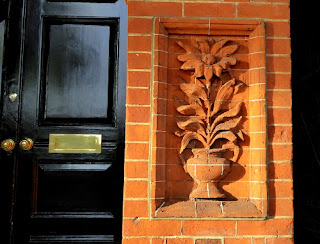









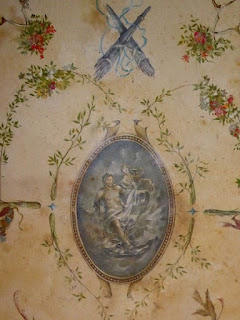

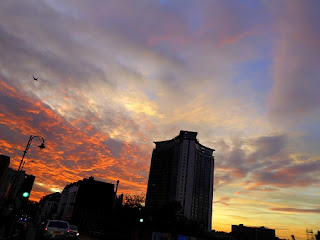


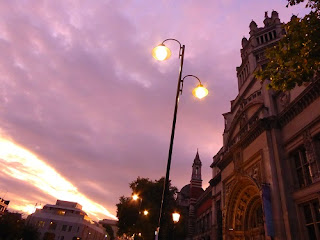



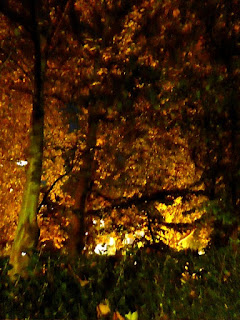

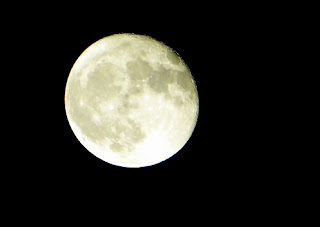












6 comments:
Some lovely photos: thank you! The mysterious object at Kew is, I think, a seed pod from a magnolia.
Thank you so much, Caro - that would make sense as the magnolia collection is close to that spot.
Such a lovely photo tour, and particularly nice to see autumn still in full sway as ours is receding here.
Oh, ours is definitely receding now, with only the London planes and beeches still colouring. A lot changes in a month - though it's good to see that Eliot's 'when golden October declines into sombre November' no longer holds, at least for the first half of the latter month.
David, you should write a book on secret London! I wish I could photograph as well as you. Love the sky scapes.
Also agree about North End Road but haven't tried that bakery yet.
Thanks, Margaret. What I like about the JBH is that it's become a kind of centre to the market - always busy, and the smokers can sit outside.
Post a Comment